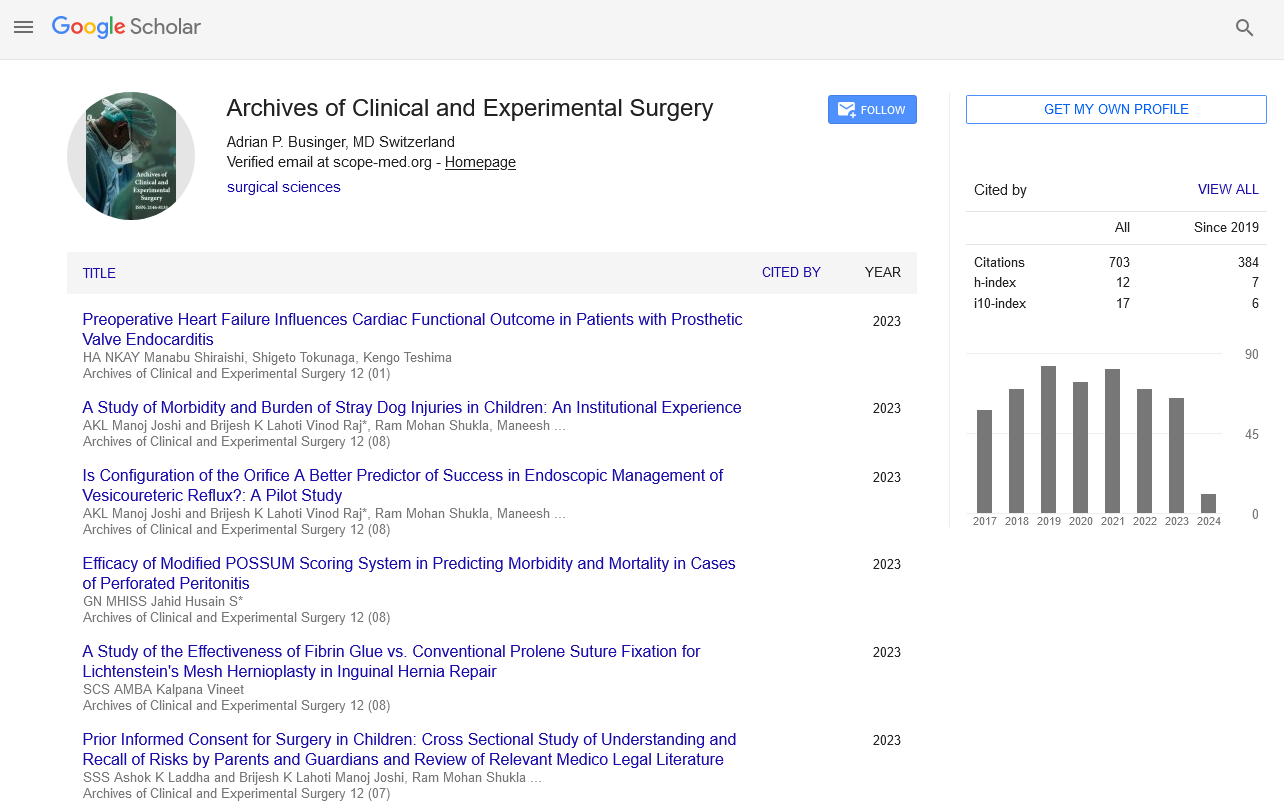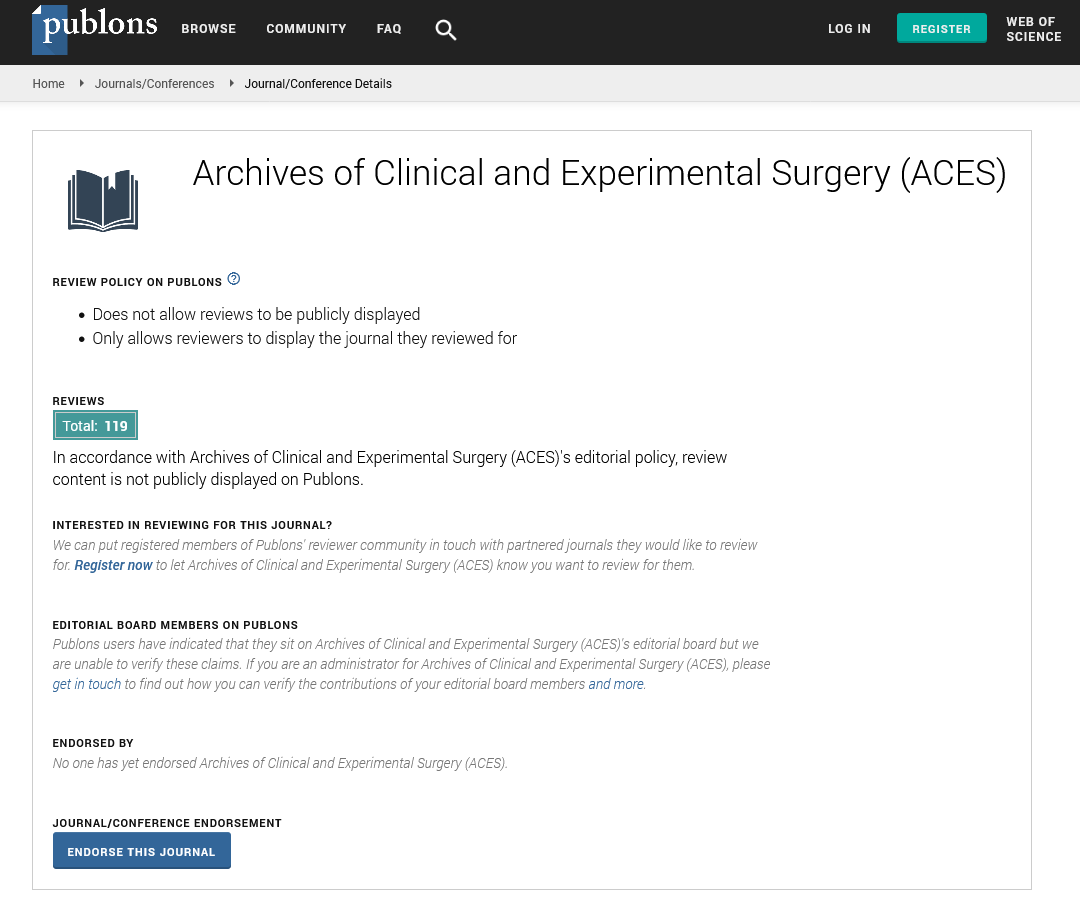Research Article - Archives of Clinical and Experimental Surgery (2025)
Delayed Diagnosis of Undescended Testis: Still a Reality
Ram Mohan Shukla, Pooja Tiwari*, Ritesh Dixit, Maneesh Joleya, Vinod Raj, B. K. Lahot, Manoj Joshi, Shashi Shankar Sharma and Ashok Kumar LaddhaPooja Tiwari, Department of Pediatric Surgery, MGMMC, Indore, India, Email: drtiwaripooja@gmail.com.in
Received: 06-Jun-2025, Manuscript No. EJMACES-25-165259; Editor assigned: 11-Jun-2025, Pre QC No. EJMACES-25-165259 (PQ); Reviewed: 25-Jun-2025, QC No. EJMACES-25-165259; Revised: 14-Jul-2025, Manuscript No. EJMACES-25-165259 (R); Published: 16-Aug-2025
Abstract
Background: Undescended Testis (UDT) is best defined as a testis that cannot be manipulated to the bottom of the scrotum without undue tension on the spermatic cord. UDT is a very common surgical problem treated by pediatric surgeons. But even today, majority of children are referred for definitive treatment at an older age. The probable reasons for late referral are lack of awareness among the general physicians, pediatricians regarding the correct age of surgery, ignorance among parents that it’s a correctable anomaly, delayed diagnosis of the condition, lack of expertise in the rural areas, financial reasons and other factors.
Materials and methods: The cross-sectional study, at a randomly selected public health institute of central India, included all patients with UDT attending pediatric surgery Outpatient Department (OPD) over a period of seven years. Patients with retractile testis and those with UDT but age less than 6 months were excluded from the study. Following parameters were observed, findings noted and statistically analyzed-name, registration number, age of presentation, cause of delay, type of presentation, diagnosis, associated anomalies, if any and operative procedure done. Sample size was calculated with Cochran’s formula and statistical analysis done using Fischer Exact test.
Results: A total of 141 patients were included in the study. The median age at which patients presented was 7.9 years. Associated anomalies were present in 12.3%. In our series, commonest cause of delay in treatment for undescended testis was found to be delayed referral by physicians in 72 patients (51.06%) followed by 31patients (21.99%) whose parents were aware but afraid to get operated at an early age, in 25 patients (17.73%) parents were unaware of the anomaly itself. Only 13 patients (9.22%) came at appropriate age for surgery.
Conclusion: Meticulous examination of external genitalia at birth by the attending nurse and pediatrician before sending the baby home is must for early diagnosis and management in developing countries like ours. Thorough education and training of the medical professionals is needed to prevent delay in management of this correctable anomaly in modern day to day practice.
Keywords
Delayed diagnosis; Undescended testis; Orchiopexy; Cryptorchidism; Children; Pediatric anomalies
Introduction
Undescended Testis (UDT) is best defined as a testis that cannot be manipulated to the bottom of the scrotum without undue tension on the spermatic cord [1]. UDT is a common congenital anomaly in children. In day-to-day clinical practice, this anomaly is encountered by different health specialists ranging from health workers, general physicians, pediatricians, general surgeons, pediatric surgeons and urologists. A very few cases reach the paediatric surgeons directly. Most important factor affecting treatment outcome has been the age of presentation.
In developed world due to better antenatal services, the detection is usually at birth and the treatment is commenced immediately, thus having virtually no complications. Meanwhile, in less privileged societies like ours, the diagnosis is delayed considerably, sometimes up to adulthood leading to higher incidence of complications like testicular atrophy, reduced testicular volume, recurrent epididymoorchitis, trauma, subfertility, malignant changes and psychological problems [2-6].
The optimum age to get undescended testis operated is also not well known to the referring physicians. Earlier the lowest age to get operated was higher but the present recommendations suggest that if testis has not descended by age of 3 months, the baby should be prepared for orchiopexy by 6-9 months of age.
In surgical centers, orchiopexy is safe in the second 6 months of life; however, in less experienced centers, surgery between 12 and 18 months may be safer [7]. Early surgery can be attributed to increased awareness about condition, early referral, more number of trained surgeons and increased availability of trained pediatric anesthetists.
The clinicians who have not updated themselves may suggest the parents to delay surgery and thus delay the definitive treatment, even after the diagnosis is made. The unaware, unmotivated and anxious parents may not be very inclined to get their young children operated. These factors in sum delay the diagnosis and management of an otherwise uncomplicated recovery.
Though studied in various setups, data from developing countries regarding the subject is scant and dependent on international findings [7]. Since the delayed diagnosis encompasses cultural andsocial factors besides medical ones, it is imperative that the condition must be assessed at local level so that more adaptive, compliant and executable recommendations can be formulated in developing countries.
We in our study have tried to find out the loop holes by studying the causes of delay, variety of presentations and definitive outcome in a rural Indian set up.
Materials and Methods
This cross-sectional study was conducted at a randomly selected public health center of central India, which encompassed total patients who attended Pediatric surgery OPD over a period of seven years from January 2014 to September 2023.
All the records were thoroughly screened. Following parameters were observed, findings noted and statistically analyzed age at the time of presentation, cause of delay, type of presentation, diagnosis, associated anomalies and operative procedure done.
Results
A total of 141 patients were studied. Sample size was calculated using Cochran’s formula (n=4pq/ d2) taking 20% non-response rate with prevalence of UDT taken as 4.9% [8]. The median age at which patients presented was 7.9 years. 66 (46.8%) patients presented with right UDT while 51 (36.2%) were having left sided anomaly. 24 (17%) presented with bilateral variety. The presence of associated anomalies was also enquired and was found to be in 12.3%. 70.2% testicular units were palpable (Tables 1 and 2)
| Unilateral undescended testis | Bilateral undescended testis |
Total | Percentage | ||
|---|---|---|---|---|---|
| Right | Left | ||||
| Palpable | 61 | 18 | 20 | 99 | 70.21 |
| Non-palpable | 5 | 6 | 4 | 15 | 10.63 |
| Total | 66 | 51 | 24 | 141 | |
| Percentage | 46.8 | 36.17 | 17.02 | ||
Table 1. Distribution of undescended testes according to laterality and palpability.
| Cause of delay | Number | Percentage |
|---|---|---|
| Unaware | 25 | 17.73 |
| Late referral | 72 | 51.06 |
| Afraid of surgery | 31 | 21.99 |
Table 2. Causes of delay in treatment of undescended testis.
Most common cause of delay was due to unawareness of clinicians which was determined by enquiring from patient’s relative about the age at which they have shown to the concerned clinician and advice given to them about the condition. Other causes included anxiety in parents due to ignorance, an obvious fear of complications of surgery and anesthesia at such an early age as well as lack of access to adequate facilities leading to delay.
In our series, commonest cause of delay is delayed referral by physicians in 72 patients (51.06%) followed by 31patients (21.99%) whose parents were aware but afraid to get operated at an early age, in 25 patients (17.73%) parents were unaware of the anomaly itself. Only 13 patients (9.22%) came at appropriate age forsurgery. Parents were aware of anomaly in 82.27% and unaware in 17.73%. The operative procedure was done in form of orchiopexy and in patients with associated anomalies needful definitive management was done.
Fischer Exact test was used to determine if there was significant association between delayed diagnosis of UDT and unawareness of clinicians regarding ideal age of surgery and p-value (<0.0001) was found to be extremely statistically significant (Table 3). thus it can be concluded that lack of awareness among clinicians is most important factor for delayed presentation of UDT and stringent actions need to be taken to spread awareness and form guidelines to reduce loss of testicular units.
|
Age when children presented for surgery |
Total |
P value |
|||
|
<= 2 years |
>2 years |
||||
|
Awareness of pediatrician/clinician* regarding ideal age of surgery |
+ |
13 |
31 |
44 |
0.0001** |
|
- |
0 |
97 |
97 |
||
|
Total |
13 |
128 |
141 |
||
|
Note: *Clinician includes urologist, general physician, family medicine physician, general surgeon, etc. other than pediatrician; **Fischer Exact test-p value <0.0001, extremely statistically significant |
|||||
Table 3. Fischer exact test.
Discussion
The aim of diagnosis at correct age (newborn) and definitive management at right age (by 6-9 months) in undescended testis is to prevent uncorrectable abnormalities of histology which can significantly affect fertility. The delay in diagnosis and referral of children with undescended testis in our study (median age 7.9 years) is significant on comparative analysis with developed countries where commonly they are diagnosed on fetal USG or at birth by the attending nurse or pediatrician [3-10].
The median age at which patients presented in our study was 7.9 years whereas it was 5.4 years in the study by Shiryazdi, et al. [11].
In our study, 90.78% patients came after the age recommended for surgery which shows the lack of awareness among the physicians and the parents of this anomaly even in today’s information flooded world. This is much higher compared to other studies reported in literature [11,12].
Fifteen patients (10.63%) presented with non palpable testis out of which two had bilateral non palpable testis. This is comparable to findings reported in literature [11]. In our series, the most common cause of delay was delayed referral by physicians followed by unawareness of the parents. This is similar to other studies published in literature (Table 4).
| S. no | First author (et al.) | Year of publication | Type of study | No of patients | Mean age of presentation |
|---|---|---|---|---|---|
| 1 | C K Sinha | 2008 | Retrospective | 250 | 4.75 years |
| 2 | S M Shiryazdi | 2011 | Cross sectional | 143 | 5.34 years |
| 3 | O.H. Ekwunife | 2018 | Retrospective+ Prospective | 39 | 4.26 years |
| 4 | S Thayyil | 2004 | Retrospective | 8 | 7.8 years |
| 5 | J J Brown | 2005 | Retrospective | 4 years | |
| 6 | D D Jiang | 2019 | Prospective | 178 | 3.67 years |
| 7 | Present study | Cross sectional | 141 | 7.9 years |
Table 4. Summary of clinical studies on undescended testes: Study type, sample size, and mean age at diagnosis.
In this study, 135 patients were provided definitive surgical treatment for UDT and associated anomalies; 6 patients were lost to follow up. In the operated group, orchiectomy (4.96%) was done in seven patients (3 with torsion and 4 of atrophic testis). These complications were preventable if the patients have been diagnosed and referred early.
Among the patients with non-palpable testis, on performing diagnostic laparoscopy we observed absent testis with blind ending vas and vessels in 4 patients. Laparoscopic assisted single stage orchiopexy was done in 7 patients and rest required Fowler Stephen’s staged orchiopexy. Thayyil S, et al. in their series found that the average age of orchiopexy decreased from 7.8 to 5.2 years on following proper protocol for diagnosis of undescended testis [13]. Brown JJ et al. also had similar findings [14]. To make the present scenario better, proper recommendations are needed at district, state and central level for early diagnosis and they should be made mandatory so that early referrals can be achieved.
Conclusion
Meticulous examination of external genitalia at birth by the attending nurse and pediatrician before sending the baby home is must for early diagnosis in our set up. Awareness programs for early detection are needed for the examining medical professionals and parents. In case of absence of testis in scrotum in newborn, the baby should be re-examined at 3 months and if the testis is still missing the baby should be referred to a pediatric surgeon for proper management.
Recommendations
• Primary health workers/Aasha/Aanganwadi workers can be trained to look for obvious congenital anomalies including UDT and to refer the suspected neonates.
• A call center can be established solely for neonatal well-being with information of callers nearest referral center.
• To update all clinicians about recent information regarding diagnosis and age of definitive management of all congenital anomalies including UDT, a brochure or information booklet can be prepared and distributed with the help of pharmaceutical companies.
• A checklist for neonatal findings can be incorporated in vaccination card.
• Imparting of relevant knowledge to expectant mothers during ANC visits. 4
• Spreading awareness, about congenital anomalies, their presentations, definitive management with stress on correct referring age, through mass media and internet, preferably in native languages and dialects.
• Policy measures to ensure optimum coverage of geographical areas with well-equipped centers for conducting pediatric surgery spread uniformly. • Policies to be included in school health programs.
• A full proof concrete national level policy regarding undescended testis and its timely management should be formulated by any national body like ICMR etc.
References
- Coran A, Adzick NS, Krummel T, Laberge JM, Shamberger R, Caldamone A. Pediatric surgery 7th edition. Mosby: St. Louis, MO. 2012.
- Osifo DO, Osaigbovo EO. The prevalence, postnatal descent, and complications of undescended testes among children who underwent neonatal circumcision in Benin city, Nigeria. J Pediatric Surg 2009;44(4):791-796.
[Crossref] [Google Scholar] [PubMed]
- Hutson MJ. Undescended testis, torsion and varicocele. Pediatr Surg. 1998.
- Ogunbiyi JO, Shittu OB, Aghadiuno PU, Lawani J. Seminoma arising in cryptorchid testes in Nigerian males. East Afr Med J. 1996;73(2):129-132.
[Google Scholar] [PubMed]
- Osegbe DN, Amaku EO. The causes of male infertility in 504 consecutive Nigerian patients. Int Urol Nephrol. 1985;17(4):349-358.
[Crossref] [Google Scholar] [PubMed]
- David OO, Iyekoretin E. Undescended testes in a developing country: A study of the management of 71 patients. Afr J Paed Surg. 2008;5(1):11-14.
[Crossref] [Google Scholar] [PubMed]
- Hutson MJ. Undescended testis, torsion and varicocele. Pediatr Surg. 1998.
- Bulemela JC, Ngibarwa EN, Ramaiya K, Bizzari C. Prevalence of undescended testis and its associated factors among under-fives seen at reproductive and child health clinic in Ifakara, Tanzania. Tanzania Med J. 2013;26(2).
- MacLellan DL, Diamond DA. Recent advances in external genitalia. Pediatr Clin North Am. 2006;53(3):449-464.
[Crossref] [Google Scholar] [PubMed]
- Teyschl O, Tůma J. The use of laparoscopy in the diagnosis, classification and treatment of the non-palpable undescended testicle. 2000.
- Shiryazdi SM, Modir A, Benrazavi S, Moosavi N, Kermani-Alghoraishi M, Ghahramani R. Causes of delay in proper treatment of patients with undescended testis. Iranian J Rep Med. 2011;9(1):37.
[Google Scholar] [PubMed]
- Sinha CK, Vinay S, Kulkarni R, Nour S. Delayed diagnosis for undescended testes. Indian Pediatr 2008;45(6):503.
[Google Scholar] [PubMed]
- Thayyil S, Shenoy M, Agrawal K. Delayed orchidopexy: Failure of screening or ascending testis. Arch Dis Child. 2004;89(9):890.
[Crossref] [Google Scholar] [PubMed]
- Brown JJ, Wacogne I, Fleckney S, Jones L, Ni Bhrolchain C. Achieving early surgery for undescended testes: Quality improvement through a multifaceted approach to guideline implementation. Child Care Health Dev 2004;30(2):97-102.
[Crossref] [Google Scholar] [PubMed]
- Jiang DD, Acevedo AM, Bayne A, Austin JC, Seideman CA. Factors associated with delay in undescended testis referral. J Pediatric Urol. 2019;15(4):380-381.
[Crossref] [Google Scholar] [PubMed]
Copyright: © 2025 The Authors. This is an open access article under the terms of the Creative Commons Attribution Non Commercial Share Alike 4.0 (https:// creativecommons.org/licenses/by-nc-sa/4.0/). This is an open access article distributed under the terms of the Creative Commons Attribution License, which permits unrestricted use, distribution, and reproduction in any medium, provided the original work is properly cited.







